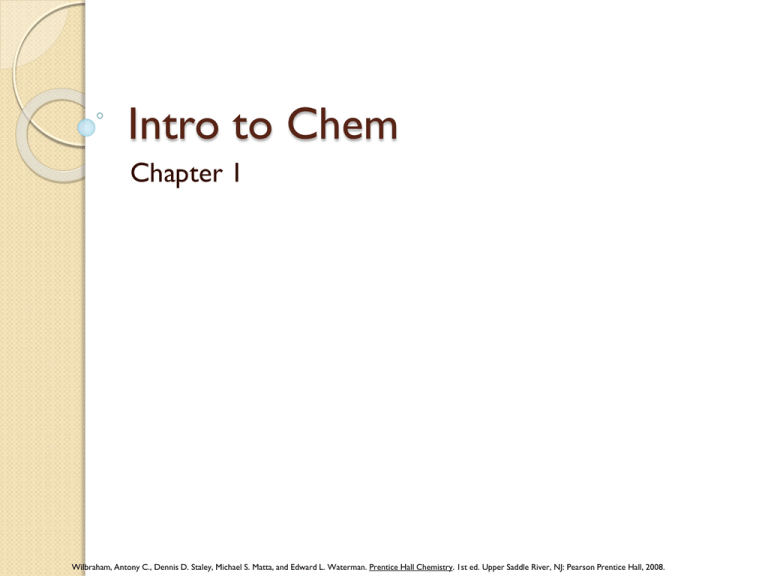
Intro to Chem
Chapter 1
Wilbraham, Antony C., Dennis D. Staley, Michael S. Matta, and Edward L. Waterman. Prentice Hall Chemistry. 1st ed. Upper Saddle River, NJ: Pearson Prentice Hall, 2008.
1.1 Chemistry
What is Chemistry
◦ Chemistry is the study of the composition of
matter and the changes that matter undergoes.
◦ Matter is anything that has mass and occupies
space
Chair, desk, air
Why is air considered matter?
◦ Since living and nonliving things are composed of
matter, chemistry affects all aspects of life and
most natural events.
How does chemistry affect your daily life?
Branches of Chemistry
Five branches of Chemistry
◦ Organic chemistry – study of chemicals
containing Carbon.
◦ Inorganic chemistry – chemicals that do not
contain carbon in general, mostly found in the
non-living
◦ Biochemistry – study of processes that take place
in organisms
◦ Analytical chemistry – study the composition of
matter
◦ Physical chemistry – study the mechanism, the
rate, & energy transfer when matter undergoes
changes.
Technology
Technology is the means by which a
society provides its members with those
things needed and desired.
◦ Space travel, robotics in the automotive
industry & surgical operations, others?
Why Study Chemistry?
Chemistry can be useful in explaining the
natural world, preparing people for career
opportunities, and producing informed
citizens.
1.1 Section Assessment
Page 11
Problems : 1 – 7, omit #3
Scientific Method
◦ Is a logical, systematic approach to the solution of
scientific problem.
◦ Steps of the Scientific Method
Make observations
Why will the lights not turn on?
Test hypothesis
Hypothesis – is a proposed explanation for an observation.
Experiment – procedure that tests the hypothesis
Develop theories
Theory – well-tested explanation for a broad set of observation.
Law – concise statement that summarizes the results of many
observations and experiments.
Collaboration and Communication
◦ Scientists collaborate and communicate to increase
the likelihood of a successful outcome.
1.3 Section Assessment
Page 25
Problems: 16 – 25; omit #20.




